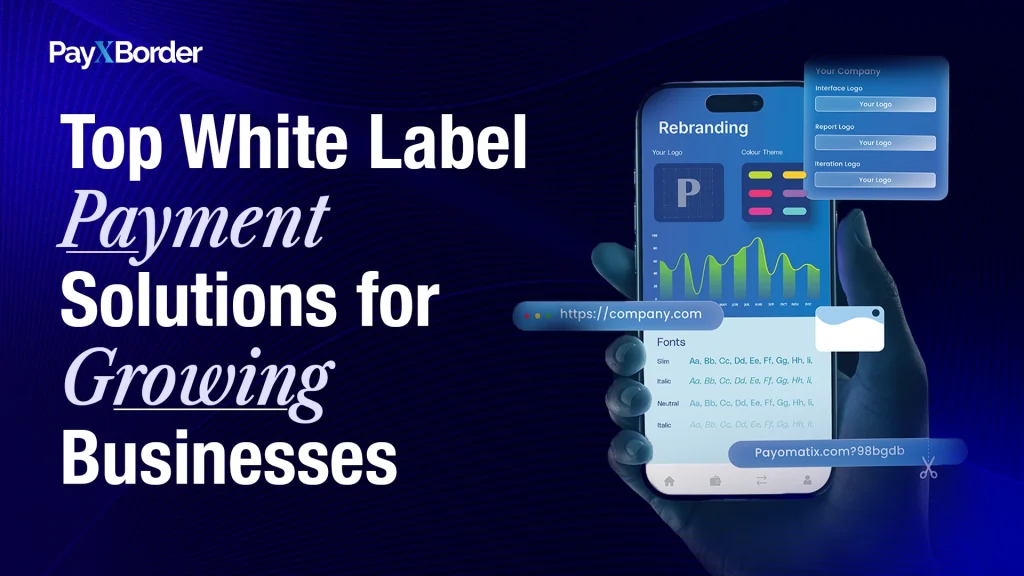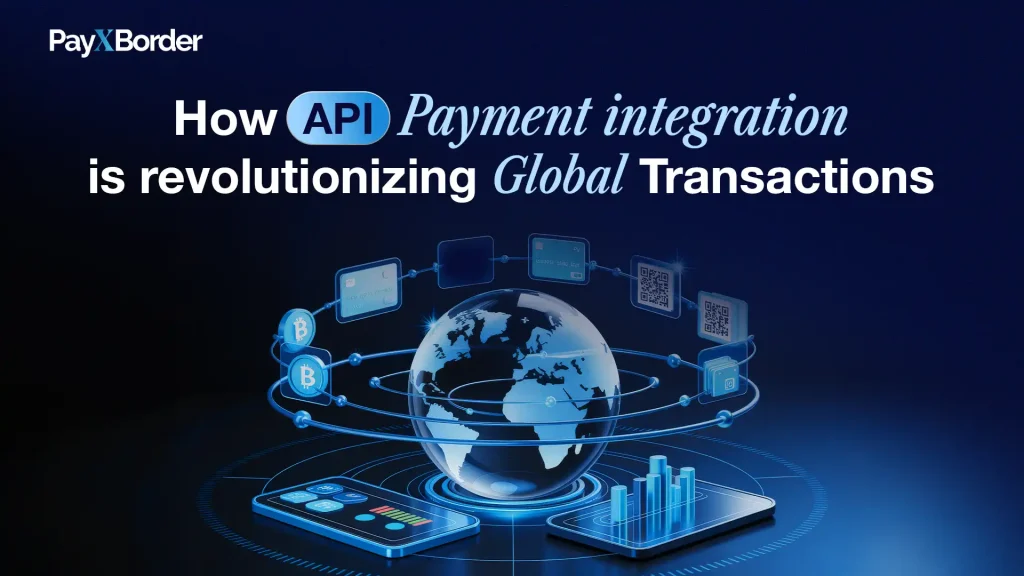“Imagine your payments flowing across borders as seamlessly as your emails. That’s the power of API Payment Integration.”
Global commerce is booming, but many businesses are still stuck managing payments manually across multiple fragmented systems, leading to delays, high costs, and inefficiencies. As businesses expand globally, the need for API Payment Integration becomes not just a convenience but a necessity.
API Payment Integration is transforming how businesses manage global transactions, automate payment flows, and enhance customer experiences while maintaining compliance and security across markets. Whether you are an eCommerce merchant, SaaS company, or multinational enterprise, embracing API payment integration is your gateway to frictionless global operations.
In this guide, we will explore what API Payment Integration means, why it matters, how it works, and how platforms like PayXBorder empower businesses to automate, optimize, and scale their payment strategies across borders effortlessly.
What Is API Payment Integration?
API Payment Integration allows businesses to connect their platforms or systems directly to payment providers using Application Programming Interfaces (APIs). This connection facilitates automated, secure, and instant payment processing without manual intervention.
Unlike traditional payment processing that requires human oversight for initiating transactions, reconciling payments, and updating records, API integration automates these processes, providing:
- Real-time payment initiation and confirmation
- Seamless currency conversions
- Automated reconciliation and reporting
- Error reduction and operational efficiency
Platforms like PayXBorder offer robust APIs that integrate seamlessly with your ERP, CRM, eCommerce platforms, and financial tools, enabling your business to automate cross-border payments while maintaining complete control.
The Challenges of Traditional Global Payment Management
Global payment management has traditionally been slow, expensive, and fragmented:
- Manual Processes: Relying on spreadsheets, emails, and manual approvals increases the risk of errors.
- Multiple Gateways: Managing different payment providers for various regions complicates workflows.
- Currency Complexity: Currency conversions often incur hidden fees and delays.
- Compliance Burden: Navigating KYC, AML, and local regulations adds administrative overhead.
- Limited Visibility: Real-time payment tracking and reconciliation are often lacking.
API Payment Integration resolves these challenges by connecting all your payment processes under one automated and intelligent system.
How API Payment Integration Works
API Payment Integration works by:
- Establishing Secure Connections: APIs connect your business systems directly to payment gateways and service providers.
- Automating Payment Workflows: Payments are initiated, processed, and confirmed automatically based on system triggers (e.g., invoice generation, order confirmation).
- Enabling Real-Time Currency Exchange: Multi-currency payments are converted instantly at competitive rates using integrated FX APIs.
- Providing Real-Time Data: Transaction statuses, payment confirmations, and reconciliations update in real time within your system.
- Ensuring Compliance: Integrated KYC and AML checks occur automatically, ensuring regulatory adherence without manual intervention.
PayXBorder’s APIs allow your business to programmatically handle global transactions while providing flexibility to build custom payment workflows tailored to your needs.
Benefits of API Payment Integration for Global Transactions
Speed and Efficiency
Payments can be triggered automatically as part of your operational workflows, reducing manual delays and enabling faster settlement cycles for suppliers, partners, and customers.
Cost Reduction
By automating payment processes, businesses reduce administrative overhead, eliminate human errors, and leverage the best FX rates to save on cross-border transaction costs.
Scalability
API payment integration enables businesses to handle growing transaction volumes and enter new markets without operational bottlenecks.
Enhanced Security
With tokenization, encryption, and advanced authentication protocols, API-driven payments reduce the risk of fraud and unauthorized access.
Improved Cash Flow Visibility
Real-time transaction updates and consolidated reporting allow finance teams to monitor cash flows accurately across currencies and regions.
Better Customer Experience
Automated and instant payments reduce waiting times, refunds, and disputes, improving trust and satisfaction.
The Role of API Payment Integration in Cross-Border Transactions
Cross-border transactions add layers of complexity:
- Currency conversion challenges
- Varying payment method preferences across regions
- Compliance with local regulations
API Payment Integration helps businesses navigate these complexities:
- Automating currency conversions at the best available rates
- Supporting local payment methods seamlessly
- Ensuring compliance through integrated KYC and AML processes
- Providing end-to-end payment tracking and transparency
For businesses operating in multiple countries, integrating payments through APIs is the most efficient way to handle scale and complexity.
Trends Driving the Adoption of API Payment Integration
1️⃣ Growth of E-Commerce and Digital Marketplaces
Global eCommerce requires fast, reliable payment systems that can handle transactions at scale, making API payment integration essential.
2️⃣ Demand for Real-Time Payments
Consumers and businesses expect instant settlements, and APIs facilitate this by enabling direct, real-time transaction processing.
3️⃣ Rise of Embedded Finance
Businesses across industries are embedding payment capabilities within their apps and platforms using API integration to enhance customer experience and drive revenue.
4️⃣ Advanced Fraud Prevention
APIs integrate with fraud detection tools, automating risk management while maintaining seamless payment flows.
5️⃣ API Standardization
Standardized API protocols across payment providers simplify the integration process, making it accessible even for SMEs.
How PayXBorder Empowers Businesses with API Payment Integration
PayXBorder offers businesses a robust API Payment Integration platform designed for cross-border transactions, providing:
- Seamless multi-currency payment processing
- Access to global payment methods and gateways
- Real-time FX rates with transparent pricing
- Automated KYC and AML compliance checks
- Real-time reporting and payment tracking
- Developer-friendly API documentation for quick integration
Whether you are automating supplier payments, managing global payroll, or processing customer transactions across borders, PayXBorder’s API infrastructure helps you do it efficiently and securely.
Compliance and Security in API Payment Integration
Security and compliance are paramount in payment processing. PayXBorder’s API infrastructure adheres to:
- PCI DSS standards for payment data security
- GDPR regulations for data privacy
- KYC/AML compliance for anti-fraud and anti-money laundering checks
- Tokenization and encryption to protect payment data
This ensures that your global payment operations remain secure while maintaining regulatory compliance.
Conclusion: API Payment Integration Is the Future of Global Transactions
The ability to process payments quickly, securely, and efficiently is crucial for businesses operating globally. API Payment Integration enables:
- Automated, scalable payment workflows
- Cost-effective cross-border transactions
- Enhanced customer experiences
- Real-time cash flow visibility
Platforms like PayXBorder are leading this transformation by providing businesses with a seamless API infrastructure to handle global transactions, enabling them to focus on growth instead of payment complexities.
Embrace the future of payments with PayXBorder’s API Payment Integration today and revolutionize your global transactions.📧: payxborder@payomatix.com
🌐: https://payxborder.in








